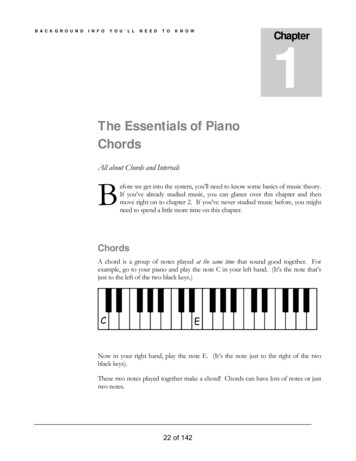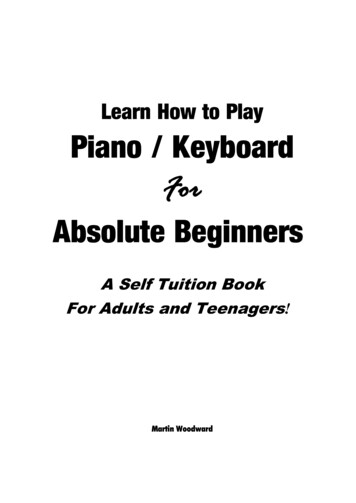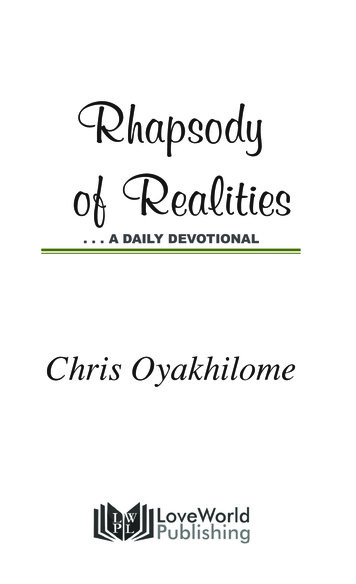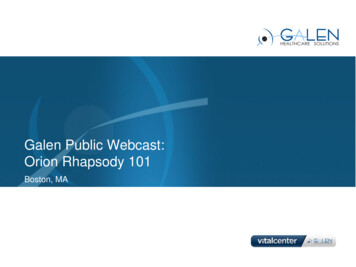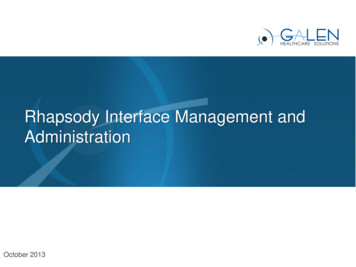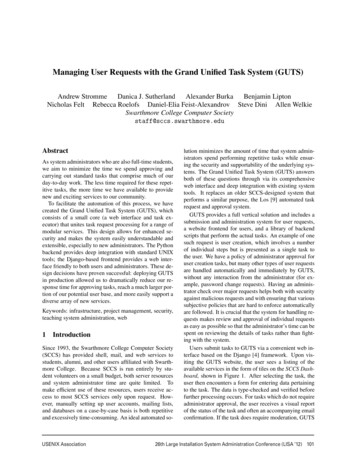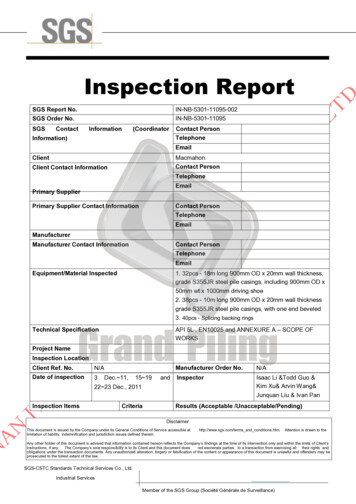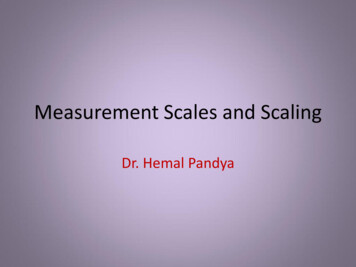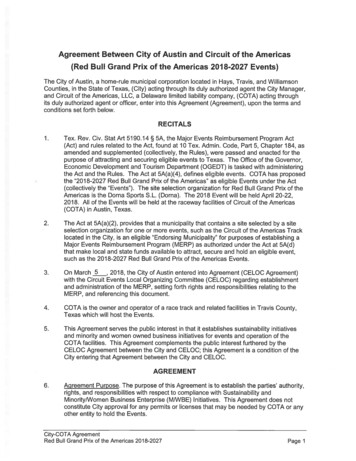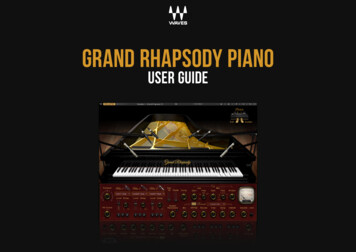
Transcription
GRAND RHAPSODY PIANOUSER GUIDE
CONTENTSCHAPTER 1 INTRODUCTION . 2Acknowledgement . 21.1 Product Overview . 31.2 Concepts and Terminology . 41.3 Components . 51.4 Functional Block/Flow Diagram . 5CHAPTER 2 QUICK START GUIDE . 6CHAPTER 3 INTERFACE AND CONTROLS . 73.1 Interface . 7Expanded View .7Collapsed View .83.2 Controls . 83.2.1 Keyboard Control . 8Keys Section .9Mix Section .11EQ Section .13Reverb Section .15CHAPTER 4 Grand Rhapsody Piano Standalone Application . 171Rhapsody Grand Piano / User Guide
CHAPTER 1 INTRODUCTIONThank you for choosing Waves! In order to get the most out of your Waves instrument, please take some time to readthrough this user guide. We also suggest that you become familiar with www.waves.com/support. There you will find anextensive answer base, the latest tech specs, detailed installation guides, new software updates, and current informationon licensing and registration.Sign up at the support site and you will receive personalized information about your registered products, reminders whenupdates are available, and information on your authorization status.AcknowledgementThe Grand Rhapsody Piano samples library was recorded and produced by Yoad Nevo at Metropolis Sound Studios inLondon.To contact Metropolis Studios, visit http://www.thisismetropolis.com/To contact Yoad Nevo, visit: http://www.yoadnevo.comImportant NoteTo play Grand Rhapsody, you must download at least one of these sample libraries in addition tothe plugin itself.2Rhapsody Grand Piano / User Guide
1.1 Product OverviewFor more than three centuries, the piano has played a huge role in music. Once introduced, it quickly gained popularityover contemporary keyboard instruments, primarily because it provided more volume and greater dynamic control. Overtime it has become a staple sound in almost all musical genres, including contemporary pop.A piano’s sound is created when a key is pressed; this activates a hammer that strikes a string. The resulting vibration isenhanced in tone and volume by the piano’s soundboard and acoustic enclosure. These, along with the position of thepiano’s cover and cover flap, influence how the piano vibrates, and therefore how its sound travels through a space (be ita room, a concert hall, or a studio). The sound of a grand piano is purely mechanical and acoustic, with no artificialreinforcement. In concert situations, microphones can be used to capture the instrument’s vibrations.Waves Grand Rhapsody Piano is based on a library sampled from a famous Fazioli 228 grand piano in Studio A atLondon’s Metropolis Studios. This library provides a full array of velocity and alternative samples for each key. Wavesalso developed a method to recreate the ethereal sound produced by the sympathetic resonances introduced by idlestrings when the sustain pedal is pressed and the string dampers lift to release the string. The played strings areaccompanied by the light resonance of the undamped strings through acoustic excitation and the resonance correlated tothe sympathetic strings. This adds nuance and realism.There are controls for velocity curve and formant. Beyond this, Waves has added studio-grade effects, including acompressor, EQ, and a high-quality digital reverb.3Rhapsody Grand Piano / User Guide
1.2 Concepts and TerminologyThe term “grand piano” refers to a piano whose strings are horizontal (i.e. parallel to the floor). Its essential partsconsist of: an action, which transfers energy from the keys to the hammers that strike the strings, and includes pedalsthat dampen or sustain string vibrations a frame and soundboard a case that forms an acoustic chamber a bridge for the strings roughly 200 stringsWaves Grand Rhapsody Piano is powered by the Waves Sampler Engine (WSE), a state-of-the-art multi-sampleengine designed to deliver solid, high-quality performance.4Rhapsody Grand Piano / User Guide
1.3 ComponentsThe Waves Grand Rhapsody Piano has one component: Grand Rhapsody Piano Stereo.This is a virtual instrument plugin and will appear under the related selection menus for virtual instruments in allsupported DAW host applications.Waves Grand Rhapsody Piano also has a standalone application. It uses ASIO (Windows) or Core Audio (Mac) driversto enable play through any audio device of choice. Grand Rhapsody Piano receives MIDI data to trigger notes and tocontrol changes.1.4 Functional Block/Flow DiagramFormantVel CurveMic 1 SamplesDelay 1Mic 2 SamplesDelay 2SustainResonanceMic 3 SamplesCompressorEqualizerReverbVolumeDelay 3Key Up SamplesPedal NoiseSamples5Rhapsody Grand Piano / User GuideLimiter
CHAPTER 2 QUICK START GUIDEInsert the Grand Rhapsody Piano plugin on an instrument track in your DAW, or launch the standaloneapplication. The plugin will load its default set of microphones and will be ready to use. Experiment withmics, reverb, EQ, and delay and you’ll soon understand how to use the controls to get the sound you want.Navigating the PresetsGrand Rhapsody Piano presets are managed with the WaveSystem Toolbar at the top of the window.Use the Next/Previous preset arrows on the Toolbar to scroll through presets. Click the Load button to see all presets.Refer to the WaveSystem Toolbar User Guide for more information at http://www.waves.com/downloads/manuals.Selecting the Samples FolderWhen you first launch the standalone application or instantiate the plugin, you will likely see a prompt, “Please locateyour Waves Instrument’s Samples Library folder.” Navigate to the folder that holds your sample library and click OK. Thispath will be saved with the plugin preferences.Information about the samples folder is shown in the WaveSystem toolbar.To select a different sample folder, click on the Samples Library bar and navigate to the desired folder. The folder mustcontain valid Waves sampled instrument files with the wsf resource, otherwise the OK button will be grayed out. Thisselection replaces the existing folder location preference.6Rhapsody Grand Piano / User Guide
CHAPTER 3 INTERFACE AND CONTROLS3.1 InterfaceThe Grand Rhapsody Piano features expanded and collapsed views. Use the Collapse/Expand button in the top leftcorner of the plugin to change between views.Expanded ViewThe expanded view reveals the Grand Rhapsody’s complete interface, showing the microphones as well as the virtualkeyboard and pedals. These controls enable auditioning directly from the interface if you don’t have a MIDI controller.7Rhapsody Grand Piano / User Guide
Collapsed ViewThe collapsed view displays all of the Grand Rhapsody controls, but hides the top part that contains the piano, mics, andpedals. This view provides complete control of the instrument. The Collapsed view uses much less screen space thanthe Expanded view.3.2 Controls3.2.1 Keyboard ControlA virtual keyboard enables you to preview the sound of a note when a keyboard controller is not available. Use a mouseor similar input device to play a note. This control cannot be automated, although it will follow any MIDI input device.8Rhapsody Grand Piano / User Guide
Keys SectionVel CurveThis control changes the curve of the velocity response from logarithmic to exponential.When the control is in 0 it is linear.Range: -50 to 50Initial Value: 0Reset Value: 0Continuous controlFormantThe formant control changes the sound character but not the pitch. Each step is equal to a half tone. This means that whenset to -12, the piano sound character will be lower by one octave, but the pitch will not change.Range: -12 to 12Initial Value: 0Reset Value: 0Discrete control, 25 steps9Rhapsody Grand Piano / User Guide
PedalsGrand Rhapsody supports the two most common piano pedals.Sustain PedalThis is the essential sustain, “damper,” pedal, connected to controller 64, which is the standard. When pressed, the Sustainresonance LED will light, indicating that sustain resonance is active. The sustain pedal is momentary—when using the pedaland when clicking on the interface. However, using MIDI-learn will provide a “latched” behavior, where first the press setssustain on and it stays on until the next press.Soft pedalThe soft pedal simulates offsetting the hammers so that they strike fewer strings. This results in a softer sound. Soft pedal isconnected to controller 67, which is standard. The soft pedal is momentary when using its original assignment of controller67. However, clicking from the interface or changing MIDI assignment using MIDI learn results in a “latched” behavior, wherethe first press sets soft pedal on, and it stays on until the next press.The pedal icons can be used on the interface when you do not have a dedicated hardware sustain or soft pedal. The sustainpedal Is momentary. The soft pedal is a toggle and will stay pressed until it’s clicked again.The pedal icons can be used on the interface when you do not have a dedicated hardware sustain or soft pedal. The sustainpedal Is momentary. The soft pedal is a toggle and will stay pressed until it’s clicked again.Both show up and can be recorded via MIDI or via automation, but not at the same time.Both pedals will trigger pedal noise samples. The level of this sound is controlled in the mix section by a single Pedal volumecontrol (see below).10Rhapsody Grand Piano / User Guide
Mix SectionMic1 Select, Mic2 Select, Mic3 SelectThe Microphone Select control allows you to choose a mic from a set of eight microphone pairs. A microphone can beselected only once, so a microphone selected as Mic1 will not appear (or appear grayed out) in the Mic Select menus of Mic2 and Mic 3.The selection consists of the following mics:Cond451 PlayerCond87 CloseDyn57 CloseCond4007 CloseCond17 MediumRibb121 MediumRibb4038 RoomCond84 RoomNone: No microphone selected for this slotMic1 Default: Cond87 Close; Mic2 Default: None; Mic3 Default: NoneMic1 Level, Mic2 Level, Mic3 LevelThe Mic Level controls set the level of the sampled sound of the piano, without pedal noise and release keys sounds. Itcontrols the level of the stereo samples in the overall mix, as recorded through the selected mic.Range: 0–100%Initial Value: Mic 1: 90%; Mic 2: 50%; Mic 3: 50%.Reset Value: Mic 1: 100%, Mic 2: 75%, Mic 3: 75%Continuous control11Rhapsody Grand Piano / User Guide
Mic1 Delay, Mic2 Delay, Mic3 DelayThe Mic Delay controls set the delay of the sampled sound of the piano. It enables controlling the phase between theselected microphones, and it can be used can add a sense of depth and dimension.Range: 0–100msInitial Value: Mic 1: 0 ms; Mic 2: 0 ms; Mic 3: 0 msReset Value: 0Continuous controlMic1 Solo Mute Invert, Mic2 Solo Mute Invert, Mic3 Solo Mute InvertBelow each microphone mix fader there are three switches:Solo places the microphone mix in solo mode. This is an exclusive button: Only one microphone mix can solo at a time.The Mute button mutes the microphone’s mix.Invert flips the phase of the microphone, along with its delay. This can be used to create “out of phase” effects and influencetone colors.Key UpKey Up is the sound of the keys while releasing. It controls the Key Up samples level in the overall mix.Range: 0–100%Initial Value: 35.5%Reset Value: 0Continuous controlPedalPedal is the sampled sound of the Grand Piano’s pedal. It controls the Pedal samples level in the overall mix.Range: 0–100%Initial Value: 24%Reset Value: 0Continuous controlCompThe Comp knob mixes between the dry and the compressed signals.Range: 0–100%Initial Value: 6%Reset Value: 0Continuous control12Rhapsody Grand Piano / User Guide
Sustain Resonance MixSu
To play Grand Rhapsody, you must download at least one of these sample libraries in addition to the plugin itself. 3 Rhapsody Grand Piano / User Guide 1.1 Product Overview For more than three centuries, the piano has played a huge role in music. Once introduced, it quickly gained popularity over contemporary keyboard instruments, primarily because it provided more volume and greater dynamic .
